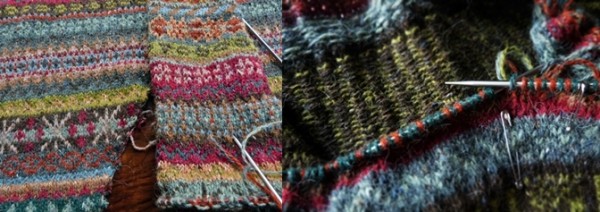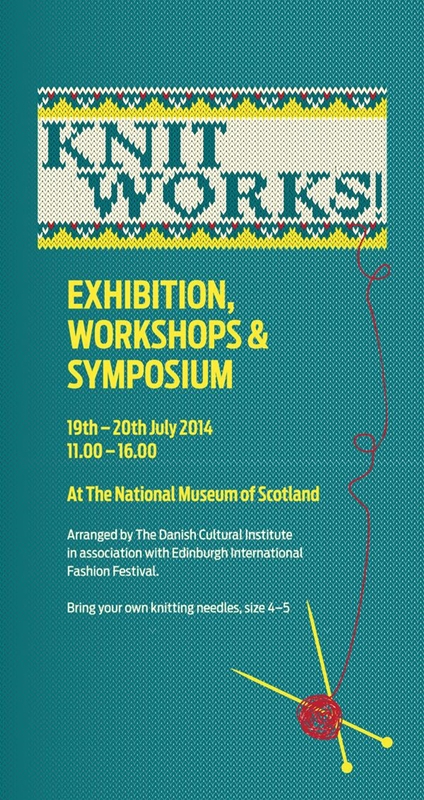This is the last entry in my series on how to make things you love to wear. We've looked at how to examine your wardrobe, how to identify what you need to make, and how to approach this. But I will be the first to admit that building a handmade everyday wardrobe takes time and money - so I thought I'd devote a post to how to 'do' slow and sustainable fashion on an everyday budget and with an everyday lifestyle. For me slow fashion and handmade go hand-in-hand.
1. The Keyword is Slow
I am not going to wake up tomorrow with a 100% handmade everyday wardrobe nor are you? Things take time - especially if you are knitting a 4ply fair isle cardigan by hand.
But slow fashion is its own reward - you get to imbue your finished cardigan with a lot of meaning which you wouldn't get from buying it in a shop. One of my favourite cardigans was nearly completed during a relaxing knitting retreat with a stunning view. Whenever I wear it (and I do so often), I think back upon the snow-capped mountains, the open fire crackling in the living room and the fine company I was in. Another favourite cardigan was partially worked whilst sitting on the beach. Whenever I wear it, I think back upon a fantastic weekend I spent with far-flung friends drinking exquisite coffee and looking at insane Regency architecture.
I am a big believer in things taking time. If you take a long time to make something, chances are you will also be wearing it a long time.

2. Choose Carefully, My Friend
In the not-so-distant past I worked for a big yarn company and I got to knit four garments of my choice every year. I started out by knitting statement pieces - things that used a gazillion balls of yarn and an equal amount of techniques. I never really wore the finished items and now I no longer work for the yarn company, I have given them away. So much wasted making time!
If you only have time to finish one or two big projects ever year, make them count. Choose your projects with care: don't work with a colour you'll never wear and don't make something in a style you'd never wear. It's easy to get tempted to get sucked into making things you see other people making, but be mindful of your crafting time.
If you have limited making time and budget, you need to think about your colours, materials and wardrobe style. Look back at the previous instalments in this series (1, 2 and 3).
3. Recognise Privilege When You See It
It's so easy to feel disheartened when you are still on the first sleeve of your wool-blend cardigan six months down the line, and you see someone looking swanky in their 134th unicorn yarn project of the year.
But a handmade wardrobe can so very easily slip into privilege: some people don't have to work; they can pay other people to mind their children, clean the house and make dinner; or they may even pay others to make their things for them (true story). Or maybe they've saved for several years to afford to make that expensive Alice Starmore kit.
You are still on your first sleeve of your cardigan but I bet you have been busy with other things. Own your achievements rather than compare yourself to other people whose lives may be heavily edited. You just never know. 'Handmade' should never be a competition about who is most worthy. Handmade should always be about your own wardrobe needs.

4. Think Sustainable When You Shop
Very few of my non-knitted clothes are handmade - but most of them are things I have either upcycled, found in second-hand shops (my favourite winter coat is 1960s 100% wool which cost me £12 in a second-hand shop. It had been labelled with the wrong size and never worn); or thrifted from friends. I cannot always afford to buy things from an ethical retailer, so while I cannot check the provenance of things nor guarantee that the original seamtress was paid a fair wage, I know my money goes towards a good cause if I buy second-hand from a reputable charity shop. I also know some of my money goes back into the local economy which is important to me.
And I think about how much I actually need. When I started doing my wardrobe assessments, I was surprised by how much I didn't actually wear. Rather than throwing things out (hello landfill) I decided to donate a lot of things so other people could benefit from me no longer having to wear business casual.
I still buy underwear, socks and tights from regular stores (I am no saint!) but I try to think about what I actually need. This also frees up extra pennies to spend on nice fabric or yarn.
5. Be Kind to Yourself
Think of your handmade wardrobe as a journey or an ongoing adventure. Remind yourself why you are doing this: you are being kind to yourself, you are making things that will get worn again and again, and you are doing it because you love making things. If you find yourself sewing an intricate organza gown on no sleep and a deadline three hours ago, then it is probably time to reassess your commitment to a handmade wardrobe (unless you wear organza gowns every day and, if you do, I admire that level of commitment).
Also consider your time investment to be a kindness to yourself. It is a powerful statement: "I choose to spend this amount of time on myself making things that will make me feel good, that will remind me of beautiful moments, and that works with my lifestyle." You may not get a handmade wardrobe overnight, but the journey there is part of the pleasure.
Now go forth and make beautiful things that you will keep wearing. Have fun.



 Keep an eye on
Keep an eye on 




